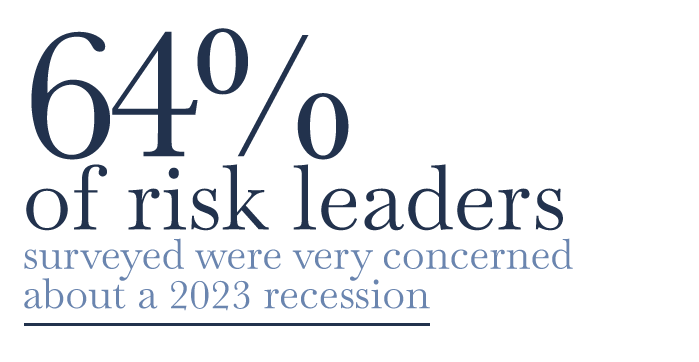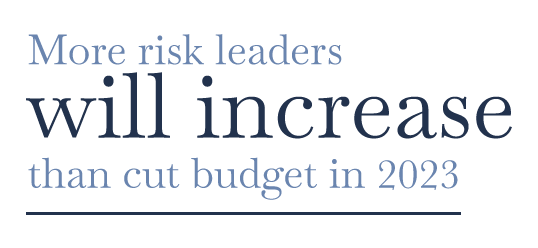2023 Tea Leaves Point to Enterprise Risk Management

The biggest tool for risk management in the days ahead is to understand the types of risks we need to be managing. Without that knowledge, it's like throwing darts in the wind and expecting to hit the right targets. Thankfully, there are two that we need to give our attention to right now.
Financial Risk
Bank of England calls Financial and Operational Resilience the top concerns in its recent Dear CEO letter. They emphasize the importance of effective risk management and governance frameworks for firms, with senior managers accountable for addressing priority areas. The deficiencies in banks' risk management frameworks were highlighted by Archegos Capital Management and reinforced by market events in 2022.
Firms must reflect on their risk management, governance, and control frameworks and review their onboarding, due diligence, and stress testing practices. The FCA will assess firms' risk management and control frameworks through individual and cross-firm thematic reviews, focusing on monitoring and managing counterparty exposures to non-bank financial institutions.
The recent PwC Pulse Survey found that 64% of risk leaders surveyed were very concerned about a 2023 recession. Global recession is not the only thing on risk leaders' minds this year. Many are looking toward increasing investment in automation to streamline compliance measures and mitigate cyber risks.

Physical Risk
The U.S. Federal Reserve has instructed the six largest banks in the country to conduct a climate risk analysis and submit a report by July. The Fed's move is in response to concerns about the financial sector's exposure to climate risks, such as physical risks from extreme weather events and the transition risks associated with the shift to a low-carbon economy. The banks, including JPMorgan Chase, Bank of America, and Citigroup, must assess the potential impact of climate change on their business operations and risk management strategies. The Fed has said it may take supervisory or enforcement action if the banks do not comply with the request.
Risk leaders remain concerned about supply chain disruption, often due to adverse weather events, in the start of the year. The same PwC survey above found that fully 82% of surveyed leaders were moderately to very concerned about operational resilience and supply chain risk. 81% indicated that they were either closely monitoring climate and clean energy proposals or were already actively engaging with lawmakers to influence policy.

Importance of Enterprise Risk Management in 2023
Enterprise Risk Management (ERM) is a process that helps organizations identify, assess, and manage risks that may affect their ability to achieve their strategic objectives. ERM has become increasingly important in recent years due to the constantly evolving business environment, which is marked by greater uncertainty, volatility, and complexity. In 2023, ERM has become even more critical for organizations of all sizes and industries due to the ongoing, geopolitical tensions, cyber threats, and other emerging risks. This article will discuss the importance of ERM in 2023, including its benefits, challenges, and best practices.
Benefits of ERM
ERM provides numerous benefits to organizations that implement it effectively. Some of the main benefits of ERM include:
Enhanced risk awareness: ERM enables organizations to identify and assess risks across all areas of their operations, from financial and operational to strategic and reputational. This enhanced risk awareness allows organizations to make more informed decisions and take proactive measures to mitigate or avoid risks.
Improved decision-making: ERM provides a structured framework for decision-making that takes into account the risks and opportunities associated with different options. This enables organizations to make more effective and efficient decisions that align with their strategic objectives.
Better risk management: ERM enables organizations to prioritize and manage risks based on their potential impact and likelihood. This helps organizations allocate their resources more effectively and efficiently, reducing the overall cost of risk management.
Increased stakeholder confidence: ERM provides stakeholders with greater confidence in an organization's ability to manage risks effectively, which can lead to improved financial performance, reputation, and overall success.
Challenges of ERM
While ERM provides numerous benefits, implementing it can also be challenging. Some of the main challenges of ERM in 2023 include:
Resistance to change: Implementing ERM requires a significant change in an organization's culture, processes, and mindset. This can be met with resistance from employees and other stakeholders who are used to traditional approaches to risk management.
Data quality and availability: ERM relies on accurate and timely data to identify and assess risks. However, many organizations struggle with data quality and availability, which can hinder their ability to implement ERM effectively.
Complexity: ERM can be a complex and time-consuming process, especially for larger organizations with multiple business units and stakeholders. This complexity can make it difficult to implement ERM consistently and efficiently.
Cost: Implementing ERM requires an investment of time and resources, which can be a barrier for some organizations, especially those with limited budgets or competing priorities.

Best Practices for ERM
To overcome these challenges and reap the benefits of ERM, organizations can adopt a number of best practices, including:
Strong leadership: ERM requires strong leadership from the top of an organization to drive change and ensure buy-in from all stakeholders. This includes setting clear goals, providing resources, and establishing accountability.
Integration with strategic planning: ERM should be integrated with an organization's strategic planning process to ensure alignment between risk management and business objectives. This enables organizations to identify and prioritize risks that are most critical to achieving their strategic goals.
Comprehensive risk assessment: ERM should include a comprehensive risk assessment that considers both internal and external risks. This includes assessing the likelihood and potential impact of risks, as well as the organization's readiness to respond to them.
Communication and training: ERM requires effective communication and training to ensure that all stakeholders understand the process and their roles and responsibilities. This includes communicating risk management policies and procedures, providing training on risk management best practices, and ensuring that stakeholders are aware of the organization's risk appetite and tolerance.
ERM in 2023
ERM has become increasingly important in 2023 due to the ongoing challenges and uncertainties faced by organizations in the current business environment. ERM provides organizations with numerous benefits, including enhanced risk awareness, improved decision-making, better risk management, and increased stakeholder confidence. However, implementing ERM can also be challenging, and requires strong leadership, integration with strategic planning, comprehensive risk assessment, and effective communication and training. By adopting these best practices, organizations can overcome these challenges and reap the benefits of ERM, ensuring their long-term success and sustainability. In short, ERM is not just a good business practice, it is essential for organizations to navigate the uncertain waters of today's world.



